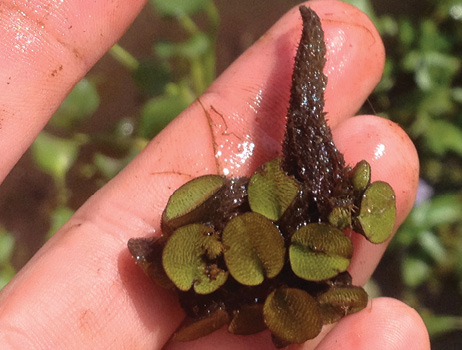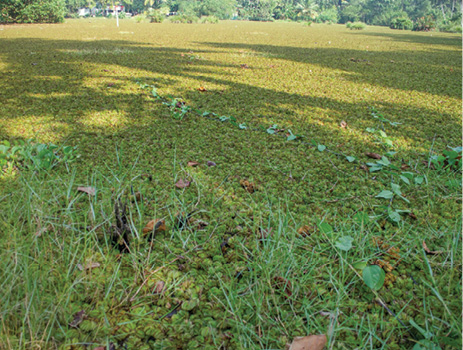Salvinia | Salvinia spp.
Floating | Non-Native



Common salvinia (Salvinia minima) and giant salvinia (Salvinia molesta) are non-native invasive plant species that are problematic in Mississippi. Salvinia are aquatic ferns that float on the water’s surface in calm areas.
The leaves of common salvinia are relatively small, ranging from one-fourth of an inch to no more than 1 inch. Giant salvinia is roughly twice as large. Leaves are hairy and may be flat, slightly bent, or heavily folded. The “roots” are modified leaves.
Both species are invasive and should be eliminated. Giant salvinia is one of the worst invasive plants worldwide. Under ideal conditions, it can form mats up to 3 feet thick that negatively impact aquatic biota and human uses of aquatic resources.
Management Value
This plant is non-native and highly invasive. Eradicate on sight.
Recommended Controls
Option 1: Flumioxazin (4.0-pound formulation). For each gallon of water, mix 0.05 ounce flumioxazin and 1.3 ounces non-ionic surfactant. Use a buffering agent when mixing with water with pH greater than 7.0. Spray to wet all exposed plants. Do not exceed annual herbicide rate limits as stated on the product label.
Option 2: Glyphosate (5.4-pound formulation). For each gallon of water, mix 1.0 ounce glyphosate and 1.3 ounces non-ionic surfactant. Spray to wet all exposed plants. Do not exceed annual herbicide rate limits as stated on the product label..
In cold temperatures (less than 50 degrees), apply flumioxazin. In warm temperatures, use glyphosate or a glyphosate plus flumioxazin tank mix.
Read and follow all chemical label instructions, especially the section on the use of personal protection equipment.

The information given here is for educational purposes only. References to commercial products, trade names, or suppliers are made with the understanding that no endorsement is implied and that no discrimination against other products or suppliers is intended.
Publication 3735-44 (POD-11-23)
By Wes Neal, PhD, Extension/Research Professor, Wildlife, Fisheries, and Aquaculture; Dennis Riecke, Fisheries Coordinator, Mississippi Department of Wildlife, Fisheries, and Parks; and Gray Turnage, PhD, Assistant Research/Extension Professor, GeoSystems Research Institute.
The Mississippi State University Extension Service is working to ensure all web content is accessible to all users. If you need assistance accessing any of our content, please email the webteam or call 662-325-2262.



